Springer Tracts in Advanced Robotics
Volume 73
Editors: Bruno Siciliano . Oussama Khatib . Frans Groen
�
Peter Corke
Robotics,
Vision and Control
Fundamental Algorithms in MATLAB®
With 393 Images
Additional material is provided at www.petercorke.com/RVC
�
Professor Bruno Siciliano, Dipartimento di Informatica e Sistemistica, Università di Napoli Federico II,
Via Claudio 21, 80125 Napoli, Italy, E-mail: siciliano@unina.it
Professor Oussama Khatib, Artificial Intelligence Laboratory, Department of Computer Science,
Stanford University, Stanford, CA 94305-9010, USA, E-mail: khatib@cs.stanford.edu
Professor Frans Groen, Department of Computer Science, Universiteit van Amsterdam, Kruislaan 403,
1098 SJ Amsterdam, The Netherlands, E-mail: groen@science.uva.nl
Author
Peter Corke
Faculty of Built Environment and Engineering
School of Engineering Systems
Queensland University of Technology (QUT)
Brisbane QLD 4000
Australia
e-mail: rvc@petercorke.com
ISBN 978-3-642-20143-1
e-ISBN 978-3-642-20144-8
DOI
10.1007
/978-3-642-20144-8
Springer Tracts in Advanced Robotics ISSN 1610-7438
Library of Congress Control Number:
2011934624
© Springer-Verlag Berlin Heidelberg 2011
This work is subject to copyright. All rights are reserved, whether the whole or part of the material
is concerned, specifically the rights of translation, reprinting, reuse of illustrations, recitations, broad-
casting, reproduction on microfilm or in any other way, and storage in data banks. Duplication of
this publication or parts thereof is permitted only under the provisions of the German Copyright
Law of September 9, 1965, in its current version, and permission for use must always be obtained
from Springer. Violations are liable to prosecution under the German Copyright Law.
The use of general descriptive names, registered names, trademarks, etc. in this publication does
not imply, even in the absence of a specific statement, that such names are exempt from the rel-
evant protective laws and regulations and therefore free for general use.
Production: Armin Stasch and Scientific Publishing Services Pvt. Ltd. Chennai, India
Typesetting and layout: Büro Stasch · Bayreuth (stasch@stasch.com)
Printed on acid-free paper
9 8 7 6 5 4 3 2 1
springer.com
�
Editorial Advisory Board
Oliver Brock, TU Berlin, Germany
Herman Bruyninckx, KU Leuven, Belgium
Raja Chatila, LAAS, France
Henrik Christensen, Georgia Tech, USA
Peter Corke, Queensland Univ. Technology, Australia
Paolo Dario, Scuola S. Anna Pisa, Italy
Rüdiger Dillmann, Univ. Karlsruhe, Germany
Ken Goldberg, UC Berkeley, USA
John Hollerbach, Univ. Utah, USA
Makoto Kaneko, Osaka Univ., Japan
Lydia Kavraki, Rice Univ., USA
Vijay Kumar, Univ. Pennsylvania, USA
Sukhan Lee, Sungkyunkwan Univ., Korea
Frank Park, Seoul National Univ., Korea
Tim Salcudean, Univ. British Columbia, Canada
Roland Siegwart, ETH Zurich, Switzerland
Gaurav Sukhatme, Univ. Southern California, USA
Sebastian Thrun, Stanford Univ., USA
Yangsheng Xu, Chinese Univ. Hong Kong, PRC
Shin’ichi Yuta, Tsukuba Univ., Japan
STAR (Springer Tracts in Advanced Robotics) has been promoted un-
der the auspices of EURON (European Robotics Research Network)
European
Research
Network
ROBOTICS
**
*
*
*
*
*
*
*
*
*
*
N
O
R
U
E
�
To my family Phillipa, Lucy and Madeline for their indulgence and support;
my parents Margaret and David for kindling my curiosity;
and to Lou Paul who planted the seed that became this book.
�
Foreword
Once upon a time, a very thick document of a dissertation from a faraway land came
to me for evaluation. Visual robot control was the thesis theme and Peter Corke was its
author. Here, I am reminded of an excerpt of my comments, which reads, this is a
masterful document, a quality of thesis one would like all of one's students to strive for,
knowing very few could attain – very well considered and executed.
The connection between robotics and vision has been, for over two decades, the
central thread of Peter Corke’s productive investigations and successful developments
and implementations. This rare experience is bearing fruit in his new book on Robotics,
Vision, and Control. In its melding of theory and application, this new book has con-
siderably benefited from the author’s unique mix of academic and real-world appli-
cation influences through his many years of work in robotic mining, flying, under-
water, and field robotics.
There have been numerous textbooks in robotics and vision, but few have reached
the level of integration, analysis, dissection, and practical illustrations evidenced in
this book. The discussion is thorough, the narrative is remarkably informative and
accessible, and the overall impression is of a significant contribution for researchers
and future investigators in our field. Most every element that could be considered as
relevant to the task seems to have been analyzed and incorporated, and the effective
use of Toolbox software echoes this thoroughness.
The reader is taken on a realistic walkthrough the fundamentals of mobile
robots, navigation, localization, manipulator-arm kinematics, dynamics, and joint-
level control, as well as camera modeling, image processing, feature extraction, and
multi-view geometry. These areas are finally brought together through extensive dis-
cussion of visual servo system. In the process, the author provides insights into how
complex problems can be decomposed and solved using powerful numerical tools
and effective software.
The Springer Tracts in Advanced Robotics (STAR) is devoted to bringing to the
research community the latest advances in the robotics field on the basis of their
significance and quality. Through a wide and timely dissemination of critical research
developments in robotics, our objective with this series is to promote more exchanges
and collaborations among the researchers in the community and contribute to fur-
ther advancements in this rapidly growing field.
Peter Corke brings a great addition to our STAR series with an authoritative
book, reaching across fields, thoughtfully conceived and brilliantly accomplished.
Oussama Khatib
Stanford, California
July 2011
�
Preface
Tell me and I will forget.
Show me and I will remember.
Involve me and I will understand.
Chinese proverb
The practice of robotics and machine vision involves the application of computational
algorithms to data. The data comes from sensors measuring the velocity of a wheel,
the angle of a robot arm’s joint or the intensities of millions of pixels that comprise an
image of the world that the robot is observing. For many robotic applications the
amount of data that needs to be processed, in real-time, is massive. For vision it can be
of the order of tens to hundreds of megabytes per second.
Progress in robots and machine vision has been, and continues to be, driven by
more effective ways to process data. This is achieved through new and more efficient
algorithms, and the dramatic increase in computational power that follows Moore’s
law. When I started in robotics and vision, in the mid 1980s, the IBM PC had been
recently released – it had a 4.77 MHz 16-bit microprocessor and 16 kbytes (expand-
able to 256 k) of memory. Over the intervening 25 years computing power has doubled
16 times which is an increase by a factor of 65 000. In the late 1980s systems capable
of real-time image processing were large 19 inch racks of equipment such as shown
in Fig. 0.1. Today there is far more computing in just a small corner of a modern
microprocessor chip.
Over the fairly recent history of robotics and machine vision a very large body of
algorithms has been developed – a significant, tangible, and collective achievement of
the research community. However its sheer size and complexity presents a barrier to
somebody entering the field. Given the many algorithms from which to choose the
obvious question is:
What is the right algorithm for this particular problem?
One strategy would be to try a few different algorithms and see which works best
for the problem at hand but this raises the next question:
How can I evaluate algorithm X on my own data without spending days coding and
debugging it from the original research papers?
Fig. 0.1.
Once upon a time a lot of
equipment was needed to do
vision-based robot control. The
author with a large rack full of
image processing and robot
control equipment (1992)
�
Respectively the trademarks of
The Mathworks Inc., Wolfram
Research, and PTC.
xii
Preface
Two developments come to our aid. The first is the availability of general purpose
mathematical software which it makes it easy to prototype algorithms. There are com-
mercial packages such as MATLAB®, Mathematica and MathCad, and open source
projects include SciLab, Octave, and PyLab. All these tools deal naturally and effort-
lessly with vectors and matrices, can create complex and beautiful graphics, and can
be used interactively or as a programming environment. The second is the open-source
movement. Many algorithms developed by researchers are available in open-source
form. They might be coded in one of the general purpose mathematical languages just
mentioned, or written in a mainstream language like C, C++ or Java.
For more than fifteen years I have been part of the open-source community and
maintained two open-source MATLAB® Toolboxes: one for robotics and one for
machine vision. They date back to my own PhD work and have evolved since then,
growing features and tracking changes to the MATLAB® language (which have been
significant over that period). The Robotics Toolbox has also been translated into a
number of different languages such as Python, SciLab and LabView.
The Toolboxes have some important virtues. Firstly, they have been around for a
long time and used by many people for many different problems so the code is entitled
to some level of trust. The Toolbox provides a “gold standard” with which to compare
new algorithms or even the same algorithms coded in new languages or executing in
new environments.
Secondly, they allow the user to work with real problems, not trivial examples. For
real robots, those with more than two links, or real images with millions of pixels the
computation is beyond unaided human ability. Thirdly, they allow us to gain insight
which is otherwise lost in the complexity. We can rapidly and easily experiment, play
what if games, and depict the results graphically using MATLAB®’s powerful display
tools such as 2D and 3D graphs and images.
Fourthly, the Toolbox code makes many common algorithms tangible and acces-
sible. You can read the code, you can apply it to your own problems, and you can ex-
tend it or rewrite it. At the very least it gives you a headstart.
The Toolboxes were always accompanied by short tutorials as well as reference mate-
rial. Over the years many people have urged me to turn this into a book and finally it
has happened! The purpose of this book is to expand on the tutorial material provided
with the Toolboxes, add many more examples, and to weave it into a narrative that
covers robotics and computer vision separately and together. I want to show how com-
plex problems can be decomposed and solved using just a few simple lines of code.
By inclination I am a hands on person. I like to program and I like to analyze data,
so it has always seemed natural to me to build tools to solve problems in robotics and
vision. The topics covered in this book are based on my own interests but also guided
by real problems that I observed over many years as a practitioner of both robotics
and computer vision. I hope that by the end of this book you will share my enthusiasm
for these topics.
I was particularly motivated to present a solid introduction to machine vision for
roboticists. The treatment of vision in robotics textbooks tends to concentrate on simple
binary vision techniques. In the book we will cover a broad range of topics including
color vision, advanced segmentation techniques such as maximally stable extremal
regions and graphcuts, image warping, stereo vision, motion estimation and image
retrieval. We also cover non-perspective imaging using fisheye lenses and catadioptric
optics. These topics are growing in importance for robotics but are not commonly
covered. Vision is a powerful sensor, and roboticists should have a solid grounding in
modern fundamentals. The last part of the book shows how vision can be used as the
primary sensor for robot control.
This book is unlike other text books, and deliberately so. Firstly, there are already a
number of excellent text books that cover robotics and computer vision separately
and in depth, but few that cover both in an integrated fashion. Achieving this integra-
tion is a principal goal of this book.
�
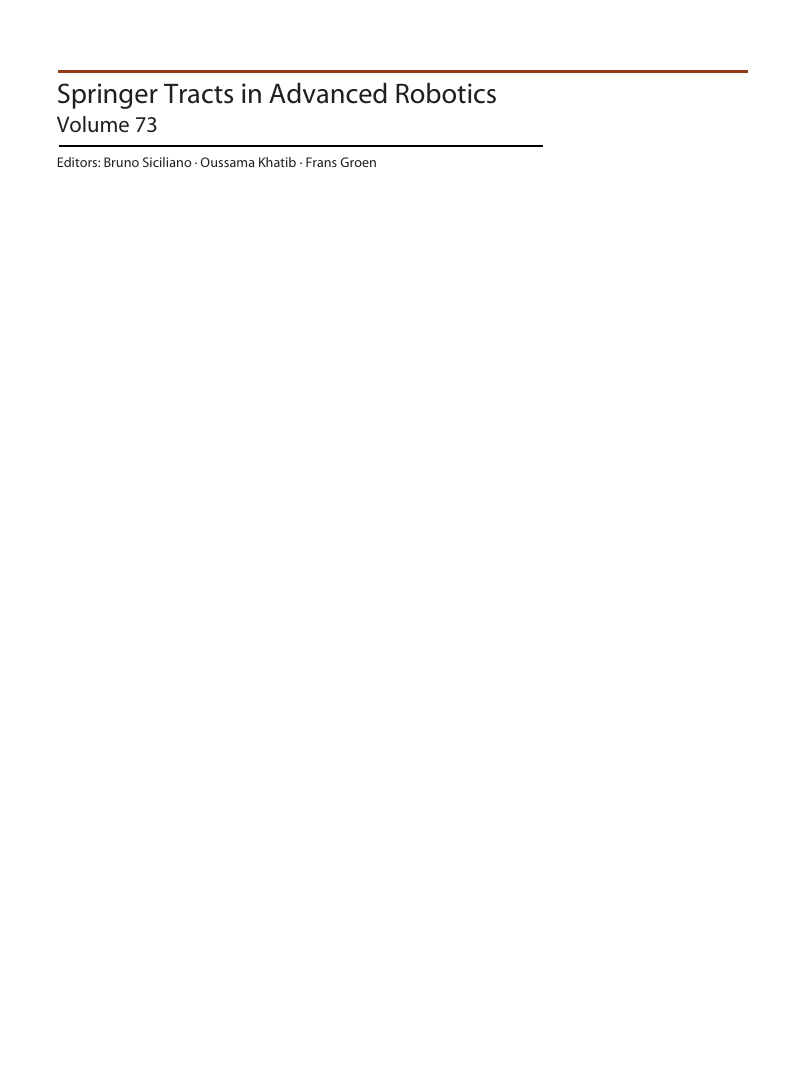
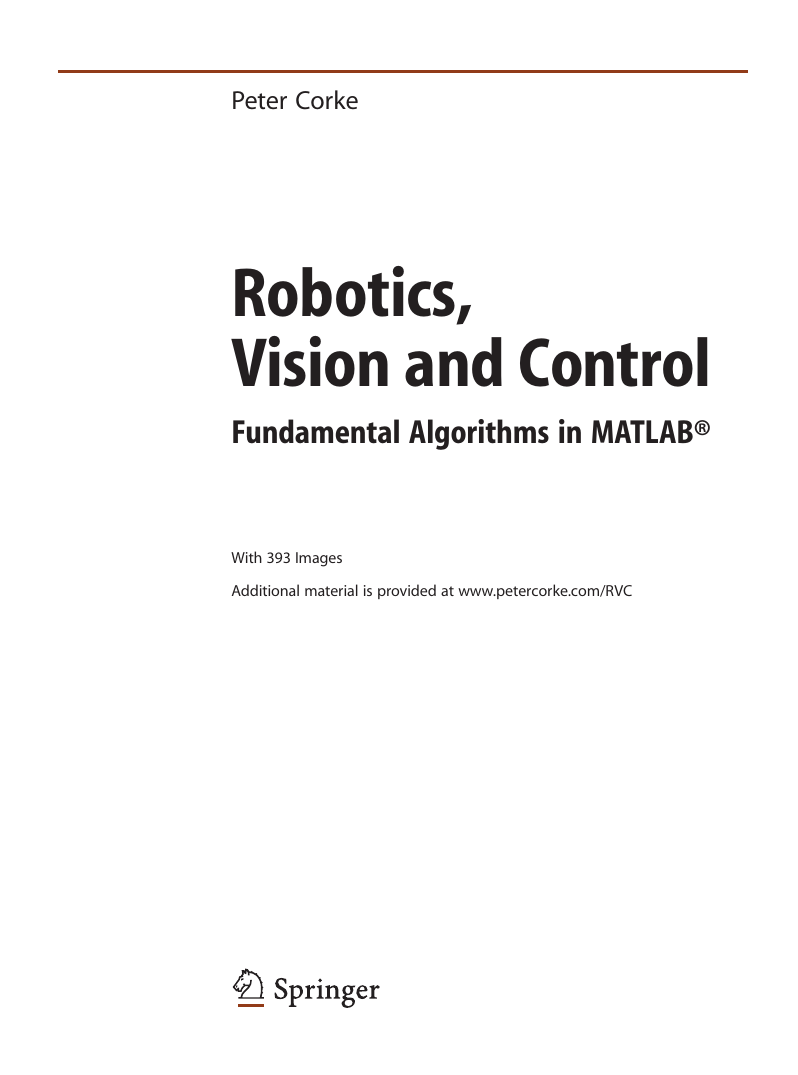
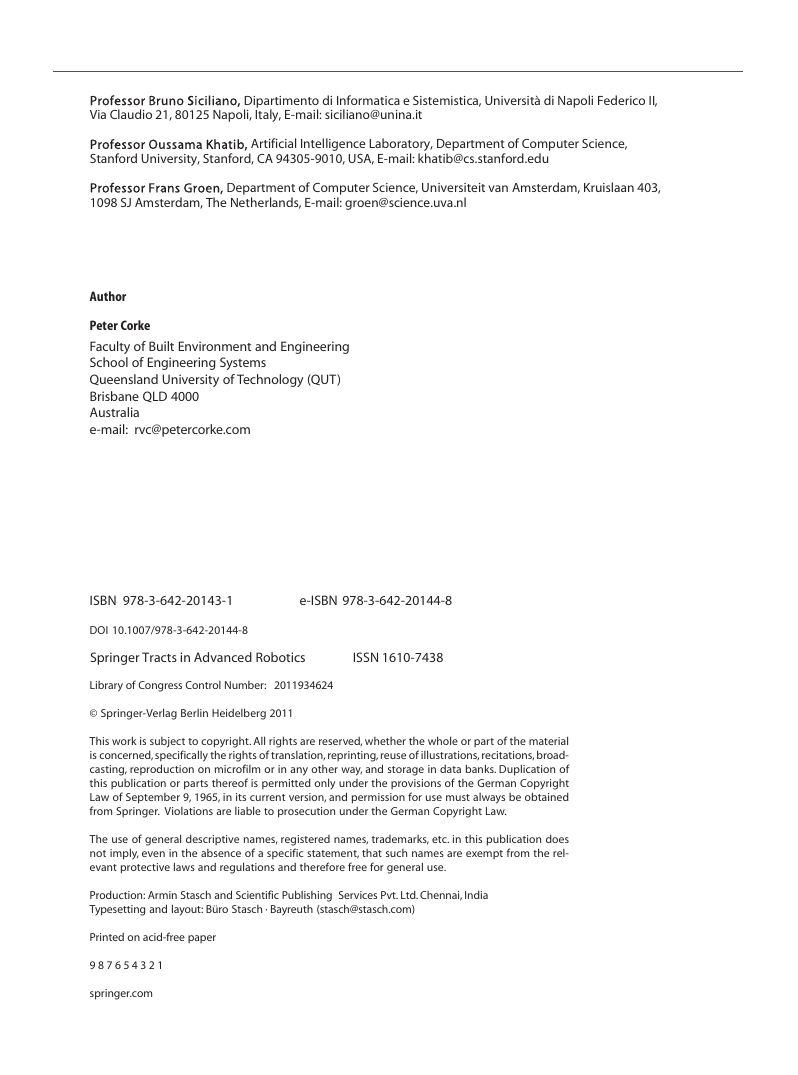
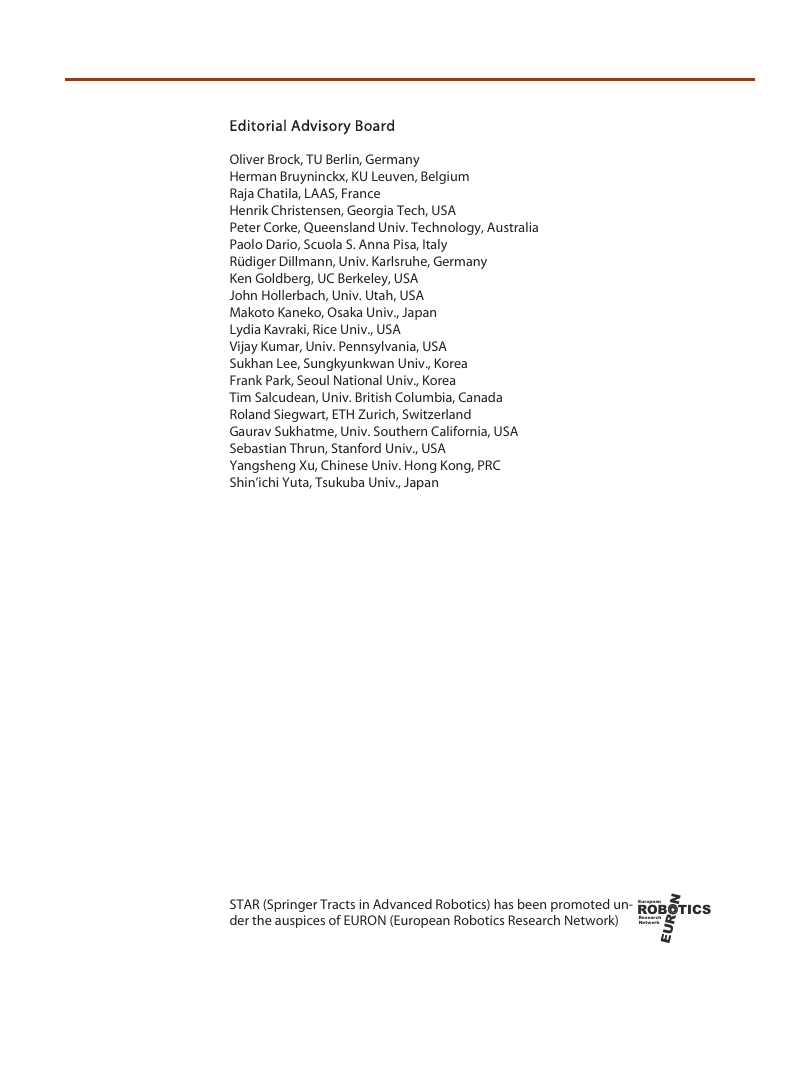

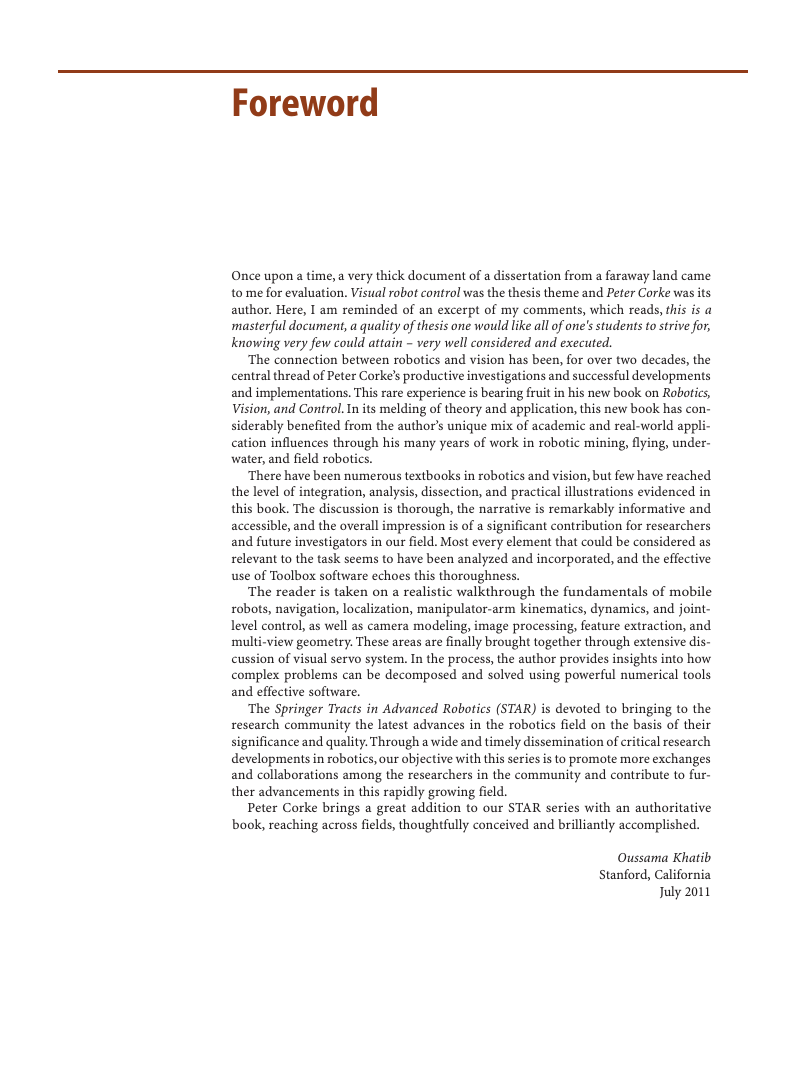
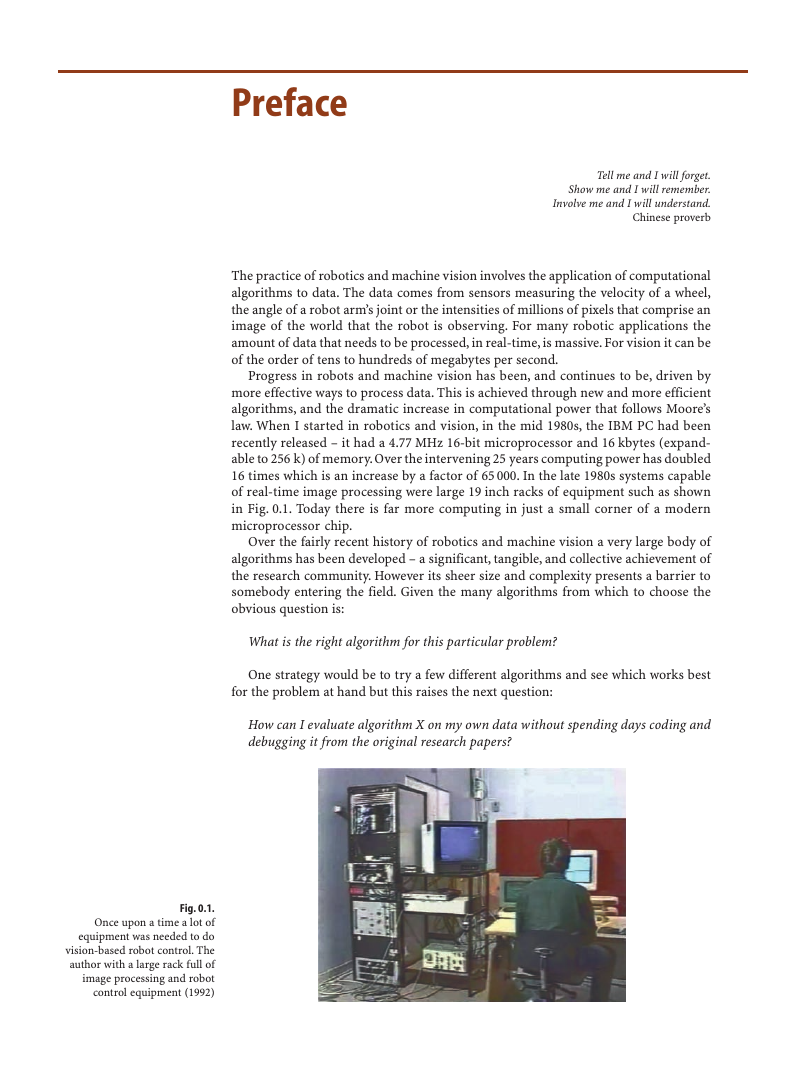









 2023年江西萍乡中考道德与法治真题及答案.doc
2023年江西萍乡中考道德与法治真题及答案.doc 2012年重庆南川中考生物真题及答案.doc
2012年重庆南川中考生物真题及答案.doc 2013年江西师范大学地理学综合及文艺理论基础考研真题.doc
2013年江西师范大学地理学综合及文艺理论基础考研真题.doc 2020年四川甘孜小升初语文真题及答案I卷.doc
2020年四川甘孜小升初语文真题及答案I卷.doc 2020年注册岩土工程师专业基础考试真题及答案.doc
2020年注册岩土工程师专业基础考试真题及答案.doc 2023-2024学年福建省厦门市九年级上学期数学月考试题及答案.doc
2023-2024学年福建省厦门市九年级上学期数学月考试题及答案.doc 2021-2022学年辽宁省沈阳市大东区九年级上学期语文期末试题及答案.doc
2021-2022学年辽宁省沈阳市大东区九年级上学期语文期末试题及答案.doc 2022-2023学年北京东城区初三第一学期物理期末试卷及答案.doc
2022-2023学年北京东城区初三第一学期物理期末试卷及答案.doc 2018上半年江西教师资格初中地理学科知识与教学能力真题及答案.doc
2018上半年江西教师资格初中地理学科知识与教学能力真题及答案.doc 2012年河北国家公务员申论考试真题及答案-省级.doc
2012年河北国家公务员申论考试真题及答案-省级.doc 2020-2021学年江苏省扬州市江都区邵樊片九年级上学期数学第一次质量检测试题及答案.doc
2020-2021学年江苏省扬州市江都区邵樊片九年级上学期数学第一次质量检测试题及答案.doc 2022下半年黑龙江教师资格证中学综合素质真题及答案.doc
2022下半年黑龙江教师资格证中学综合素质真题及答案.doc